Analyzing Talent Management's Effect on HR: Premier Inn Case Study
VerifiedAdded on 2023/01/10
|18
|5218
|24
Project
AI Summary
This project report investigates the influence of talent management on the role of Human Resources within the hospitality sector, specifically focusing on Premier Inn. The research explores the concept of talent management, examining the strategies employed by HR departments and the challenges they encounter. The report includes a literature review, detailing the conception of talent management, HR strategies like detailed job descriptions and reward systems, and challenges such as employee turnover and lack of leadership. The methodology section outlines the research philosophy (positivism), approach (deductive), and methods (qualitative and quantitative). The findings, discussion, recommendations, and conclusion provide insights into talent management practices and their impact on HR functions within Premier Inn. The report aims to offer recommendations for improving talent management and enhancing HR's role in the hospitality industry, based on the analysis of the case study.
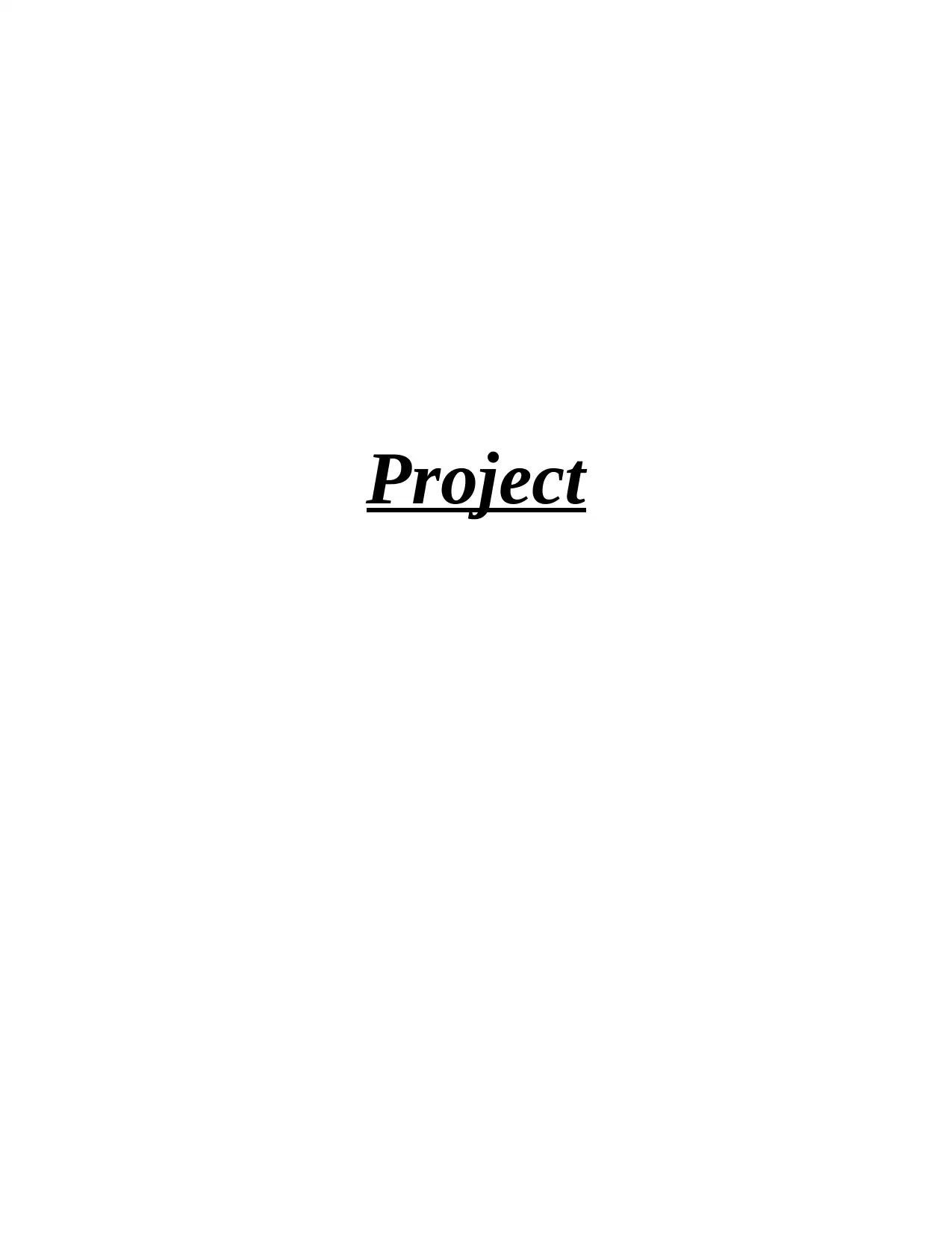
Project
Paraphrase This Document
Need a fresh take? Get an instant paraphrase of this document with our AI Paraphraser
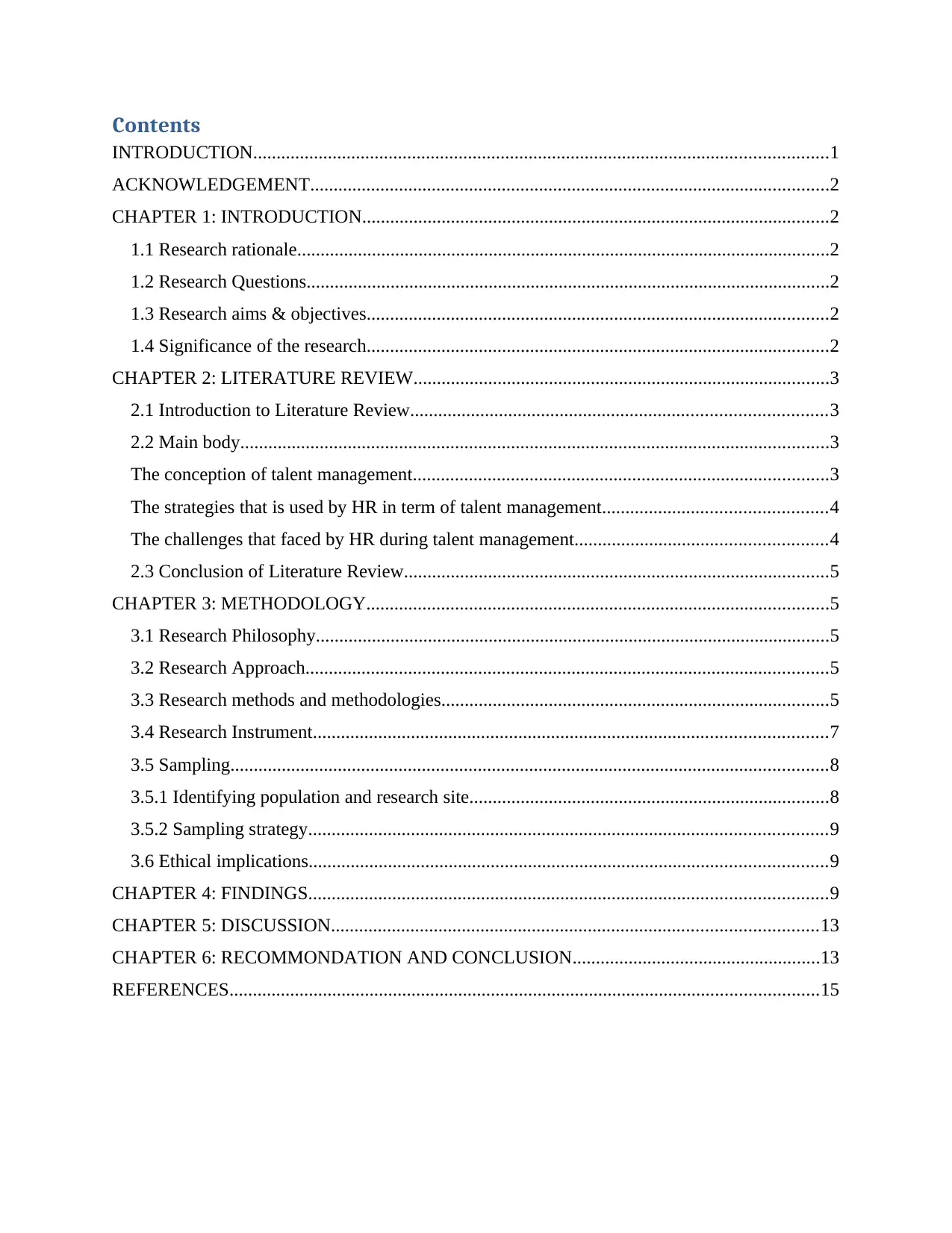
Contents
INTRODUCTION...........................................................................................................................1
ACKNOWLEDGEMENT...............................................................................................................2
CHAPTER 1: INTRODUCTION....................................................................................................2
1.1 Research rationale..................................................................................................................2
1.2 Research Questions................................................................................................................2
1.3 Research aims & objectives...................................................................................................2
1.4 Significance of the research...................................................................................................2
CHAPTER 2: LITERATURE REVIEW.........................................................................................3
2.1 Introduction to Literature Review.........................................................................................3
2.2 Main body..............................................................................................................................3
The conception of talent management.........................................................................................3
The strategies that is used by HR in term of talent management................................................4
The challenges that faced by HR during talent management......................................................4
2.3 Conclusion of Literature Review...........................................................................................5
CHAPTER 3: METHODOLOGY...................................................................................................5
3.1 Research Philosophy..............................................................................................................5
3.2 Research Approach................................................................................................................5
3.3 Research methods and methodologies...................................................................................5
3.4 Research Instrument..............................................................................................................7
3.5 Sampling................................................................................................................................8
3.5.1 Identifying population and research site.............................................................................8
3.5.2 Sampling strategy...............................................................................................................9
3.6 Ethical implications...............................................................................................................9
CHAPTER 4: FINDINGS...............................................................................................................9
CHAPTER 5: DISCUSSION........................................................................................................13
CHAPTER 6: RECOMMONDATION AND CONCLUSION.....................................................13
REFERENCES..............................................................................................................................15
INTRODUCTION...........................................................................................................................1
ACKNOWLEDGEMENT...............................................................................................................2
CHAPTER 1: INTRODUCTION....................................................................................................2
1.1 Research rationale..................................................................................................................2
1.2 Research Questions................................................................................................................2
1.3 Research aims & objectives...................................................................................................2
1.4 Significance of the research...................................................................................................2
CHAPTER 2: LITERATURE REVIEW.........................................................................................3
2.1 Introduction to Literature Review.........................................................................................3
2.2 Main body..............................................................................................................................3
The conception of talent management.........................................................................................3
The strategies that is used by HR in term of talent management................................................4
The challenges that faced by HR during talent management......................................................4
2.3 Conclusion of Literature Review...........................................................................................5
CHAPTER 3: METHODOLOGY...................................................................................................5
3.1 Research Philosophy..............................................................................................................5
3.2 Research Approach................................................................................................................5
3.3 Research methods and methodologies...................................................................................5
3.4 Research Instrument..............................................................................................................7
3.5 Sampling................................................................................................................................8
3.5.1 Identifying population and research site.............................................................................8
3.5.2 Sampling strategy...............................................................................................................9
3.6 Ethical implications...............................................................................................................9
CHAPTER 4: FINDINGS...............................................................................................................9
CHAPTER 5: DISCUSSION........................................................................................................13
CHAPTER 6: RECOMMONDATION AND CONCLUSION.....................................................13
REFERENCES..............................................................................................................................15
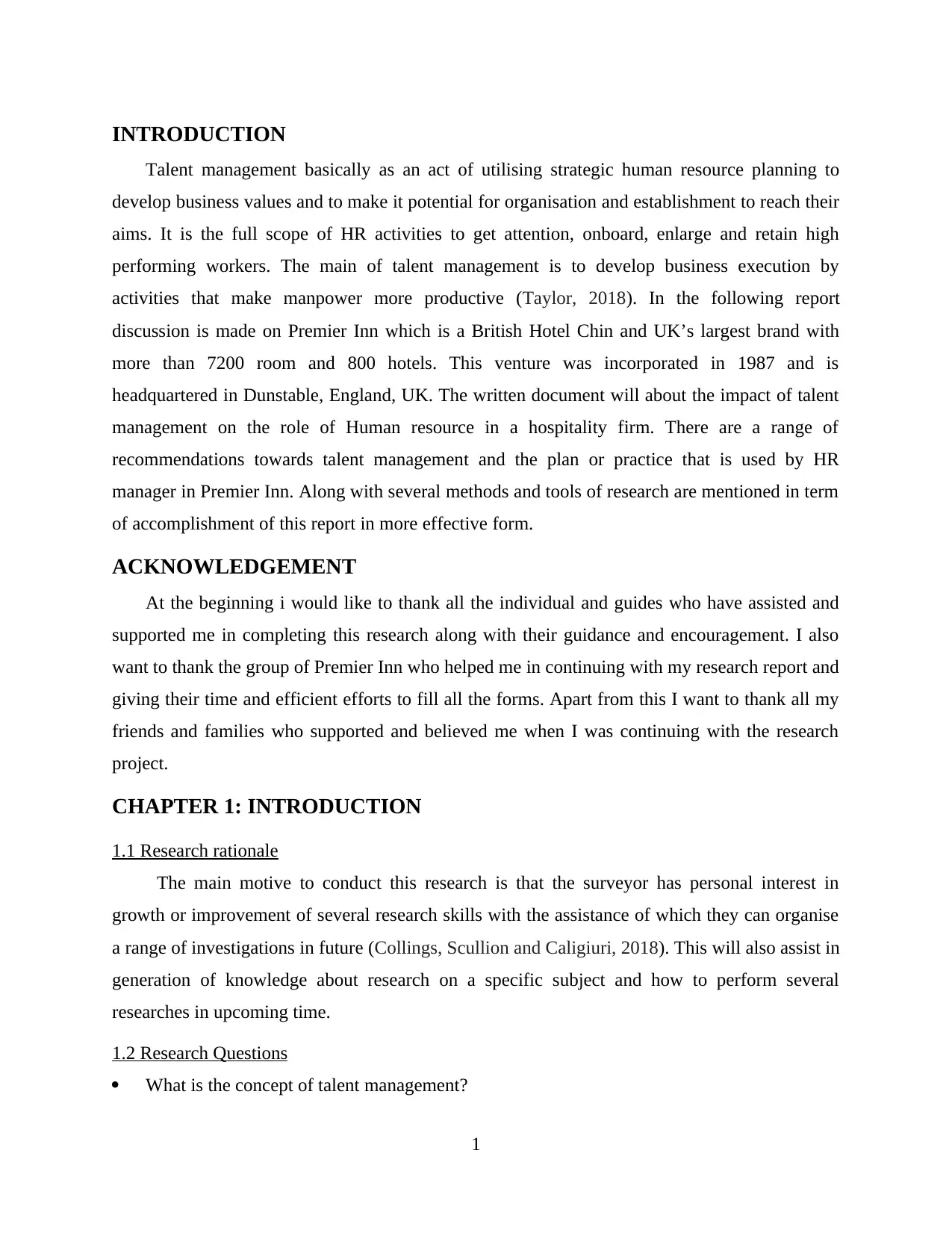
INTRODUCTION
Talent management basically as an act of utilising strategic human resource planning to
develop business values and to make it potential for organisation and establishment to reach their
aims. It is the full scope of HR activities to get attention, onboard, enlarge and retain high
performing workers. The main of talent management is to develop business execution by
activities that make manpower more productive (Taylor, 2018). In the following report
discussion is made on Premier Inn which is a British Hotel Chin and UK’s largest brand with
more than 7200 room and 800 hotels. This venture was incorporated in 1987 and is
headquartered in Dunstable, England, UK. The written document will about the impact of talent
management on the role of Human resource in a hospitality firm. There are a range of
recommendations towards talent management and the plan or practice that is used by HR
manager in Premier Inn. Along with several methods and tools of research are mentioned in term
of accomplishment of this report in more effective form.
ACKNOWLEDGEMENT
At the beginning i would like to thank all the individual and guides who have assisted and
supported me in completing this research along with their guidance and encouragement. I also
want to thank the group of Premier Inn who helped me in continuing with my research report and
giving their time and efficient efforts to fill all the forms. Apart from this I want to thank all my
friends and families who supported and believed me when I was continuing with the research
project.
CHAPTER 1: INTRODUCTION
1.1 Research rationale
The main motive to conduct this research is that the surveyor has personal interest in
growth or improvement of several research skills with the assistance of which they can organise
a range of investigations in future (Collings, Scullion and Caligiuri, 2018). This will also assist in
generation of knowledge about research on a specific subject and how to perform several
researches in upcoming time.
1.2 Research Questions
What is the concept of talent management?
1
Talent management basically as an act of utilising strategic human resource planning to
develop business values and to make it potential for organisation and establishment to reach their
aims. It is the full scope of HR activities to get attention, onboard, enlarge and retain high
performing workers. The main of talent management is to develop business execution by
activities that make manpower more productive (Taylor, 2018). In the following report
discussion is made on Premier Inn which is a British Hotel Chin and UK’s largest brand with
more than 7200 room and 800 hotels. This venture was incorporated in 1987 and is
headquartered in Dunstable, England, UK. The written document will about the impact of talent
management on the role of Human resource in a hospitality firm. There are a range of
recommendations towards talent management and the plan or practice that is used by HR
manager in Premier Inn. Along with several methods and tools of research are mentioned in term
of accomplishment of this report in more effective form.
ACKNOWLEDGEMENT
At the beginning i would like to thank all the individual and guides who have assisted and
supported me in completing this research along with their guidance and encouragement. I also
want to thank the group of Premier Inn who helped me in continuing with my research report and
giving their time and efficient efforts to fill all the forms. Apart from this I want to thank all my
friends and families who supported and believed me when I was continuing with the research
project.
CHAPTER 1: INTRODUCTION
1.1 Research rationale
The main motive to conduct this research is that the surveyor has personal interest in
growth or improvement of several research skills with the assistance of which they can organise
a range of investigations in future (Collings, Scullion and Caligiuri, 2018). This will also assist in
generation of knowledge about research on a specific subject and how to perform several
researches in upcoming time.
1.2 Research Questions
What is the concept of talent management?
1
⊘ This is a preview!⊘
Do you want full access?
Subscribe today to unlock all pages.

Trusted by 1+ million students worldwide
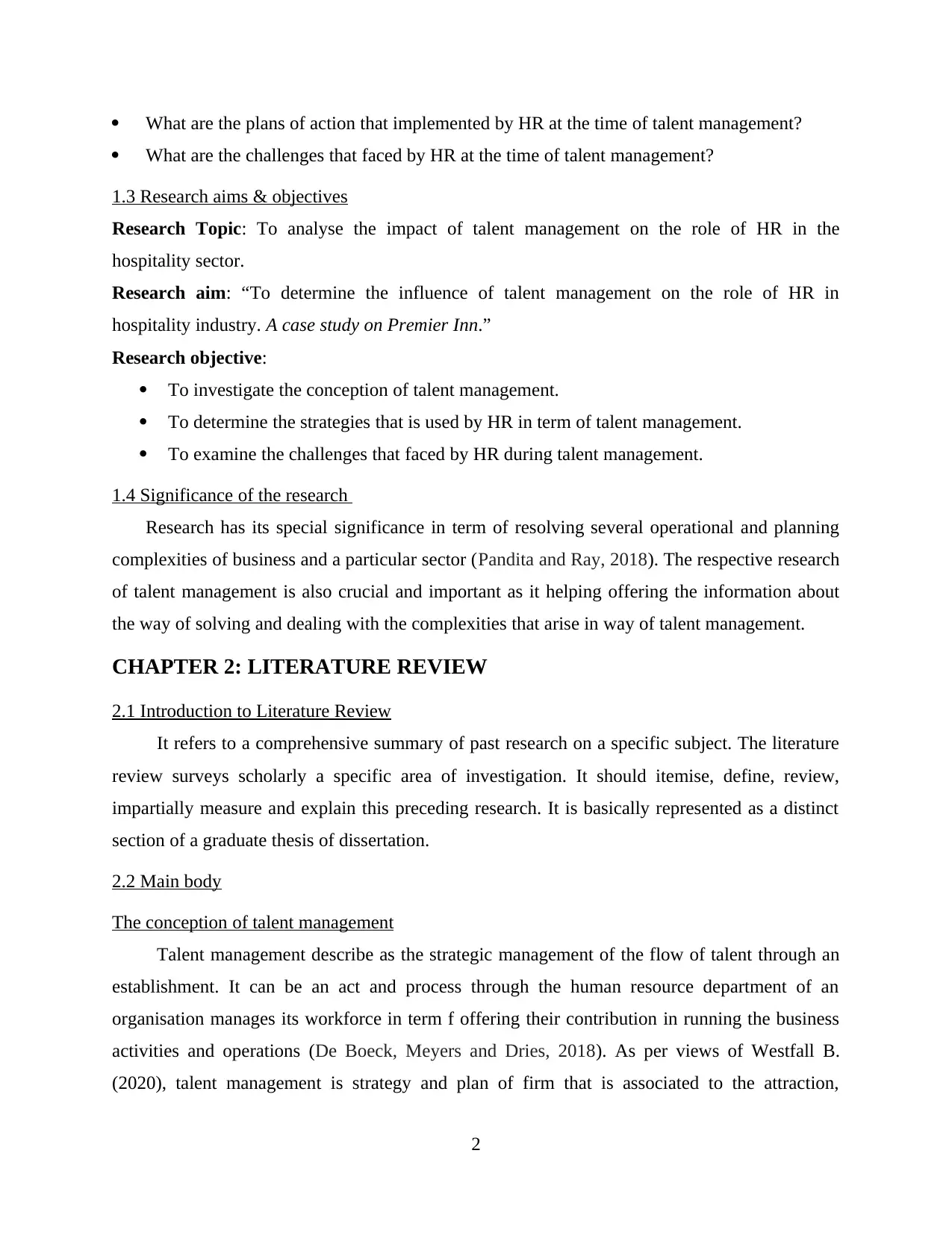
What are the plans of action that implemented by HR at the time of talent management?
What are the challenges that faced by HR at the time of talent management?
1.3 Research aims & objectives
Research Topic: To analyse the impact of talent management on the role of HR in the
hospitality sector.
Research aim: “To determine the influence of talent management on the role of HR in
hospitality industry. A case study on Premier Inn.”
Research objective:
To investigate the conception of talent management.
To determine the strategies that is used by HR in term of talent management.
To examine the challenges that faced by HR during talent management.
1.4 Significance of the research
Research has its special significance in term of resolving several operational and planning
complexities of business and a particular sector (Pandita and Ray, 2018). The respective research
of talent management is also crucial and important as it helping offering the information about
the way of solving and dealing with the complexities that arise in way of talent management.
CHAPTER 2: LITERATURE REVIEW
2.1 Introduction to Literature Review
It refers to a comprehensive summary of past research on a specific subject. The literature
review surveys scholarly a specific area of investigation. It should itemise, define, review,
impartially measure and explain this preceding research. It is basically represented as a distinct
section of a graduate thesis of dissertation.
2.2 Main body
The conception of talent management
Talent management describe as the strategic management of the flow of talent through an
establishment. It can be an act and process through the human resource department of an
organisation manages its workforce in term f offering their contribution in running the business
activities and operations (De Boeck, Meyers and Dries, 2018). As per views of Westfall B.
(2020), talent management is strategy and plan of firm that is associated to the attraction,
2
What are the challenges that faced by HR at the time of talent management?
1.3 Research aims & objectives
Research Topic: To analyse the impact of talent management on the role of HR in the
hospitality sector.
Research aim: “To determine the influence of talent management on the role of HR in
hospitality industry. A case study on Premier Inn.”
Research objective:
To investigate the conception of talent management.
To determine the strategies that is used by HR in term of talent management.
To examine the challenges that faced by HR during talent management.
1.4 Significance of the research
Research has its special significance in term of resolving several operational and planning
complexities of business and a particular sector (Pandita and Ray, 2018). The respective research
of talent management is also crucial and important as it helping offering the information about
the way of solving and dealing with the complexities that arise in way of talent management.
CHAPTER 2: LITERATURE REVIEW
2.1 Introduction to Literature Review
It refers to a comprehensive summary of past research on a specific subject. The literature
review surveys scholarly a specific area of investigation. It should itemise, define, review,
impartially measure and explain this preceding research. It is basically represented as a distinct
section of a graduate thesis of dissertation.
2.2 Main body
The conception of talent management
Talent management describe as the strategic management of the flow of talent through an
establishment. It can be an act and process through the human resource department of an
organisation manages its workforce in term f offering their contribution in running the business
activities and operations (De Boeck, Meyers and Dries, 2018). As per views of Westfall B.
(2020), talent management is strategy and plan of firm that is associated to the attraction,
2
Paraphrase This Document
Need a fresh take? Get an instant paraphrase of this document with our AI Paraphraser
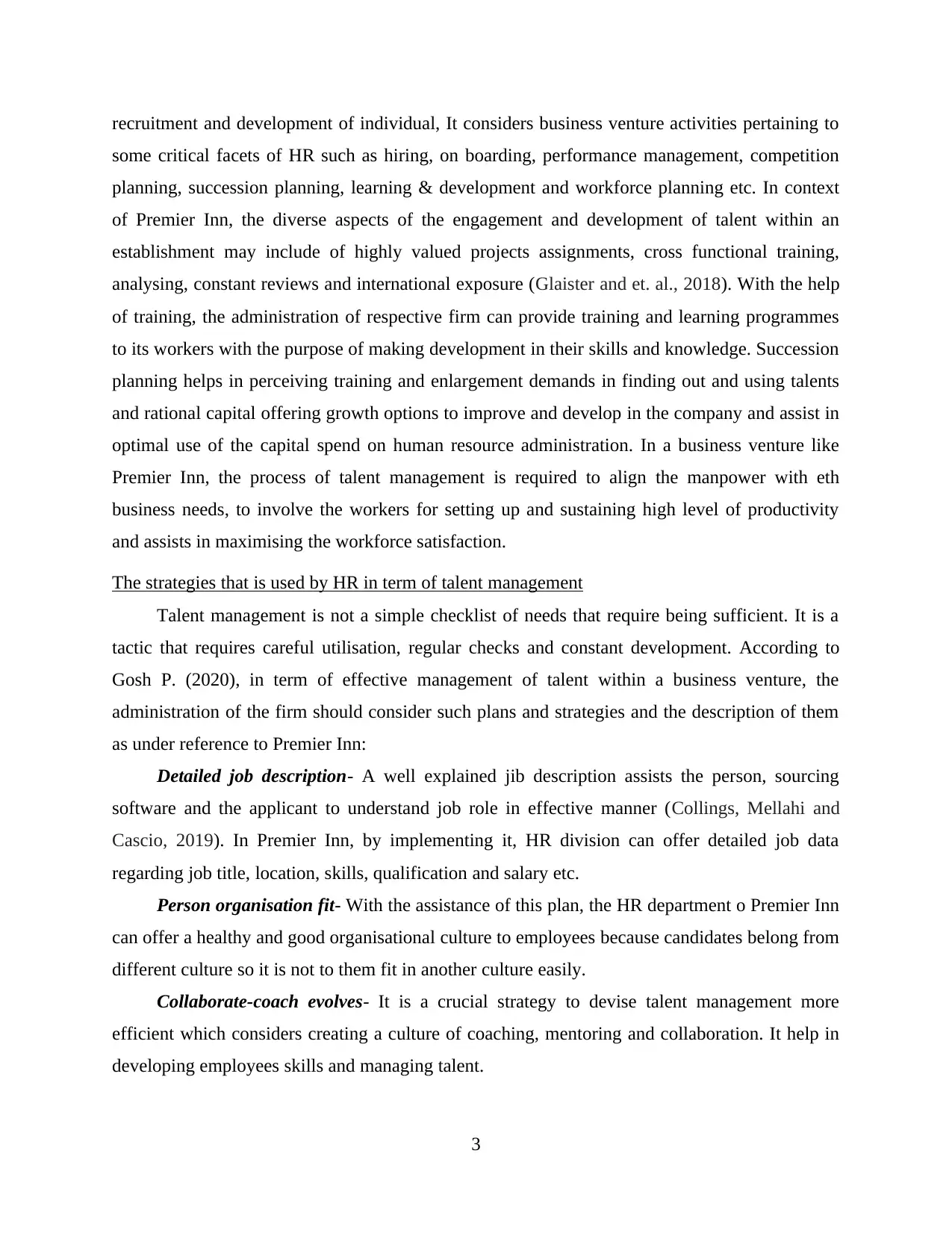
recruitment and development of individual, It considers business venture activities pertaining to
some critical facets of HR such as hiring, on boarding, performance management, competition
planning, succession planning, learning & development and workforce planning etc. In context
of Premier Inn, the diverse aspects of the engagement and development of talent within an
establishment may include of highly valued projects assignments, cross functional training,
analysing, constant reviews and international exposure (Glaister and et. al., 2018). With the help
of training, the administration of respective firm can provide training and learning programmes
to its workers with the purpose of making development in their skills and knowledge. Succession
planning helps in perceiving training and enlargement demands in finding out and using talents
and rational capital offering growth options to improve and develop in the company and assist in
optimal use of the capital spend on human resource administration. In a business venture like
Premier Inn, the process of talent management is required to align the manpower with eth
business needs, to involve the workers for setting up and sustaining high level of productivity
and assists in maximising the workforce satisfaction.
The strategies that is used by HR in term of talent management
Talent management is not a simple checklist of needs that require being sufficient. It is a
tactic that requires careful utilisation, regular checks and constant development. According to
Gosh P. (2020), in term of effective management of talent within a business venture, the
administration of the firm should consider such plans and strategies and the description of them
as under reference to Premier Inn:
Detailed job description- A well explained jib description assists the person, sourcing
software and the applicant to understand job role in effective manner (Collings, Mellahi and
Cascio, 2019). In Premier Inn, by implementing it, HR division can offer detailed job data
regarding job title, location, skills, qualification and salary etc.
Person organisation fit- With the assistance of this plan, the HR department o Premier Inn
can offer a healthy and good organisational culture to employees because candidates belong from
different culture so it is not to them fit in another culture easily.
Collaborate-coach evolves- It is a crucial strategy to devise talent management more
efficient which considers creating a culture of coaching, mentoring and collaboration. It help in
developing employees skills and managing talent.
3
some critical facets of HR such as hiring, on boarding, performance management, competition
planning, succession planning, learning & development and workforce planning etc. In context
of Premier Inn, the diverse aspects of the engagement and development of talent within an
establishment may include of highly valued projects assignments, cross functional training,
analysing, constant reviews and international exposure (Glaister and et. al., 2018). With the help
of training, the administration of respective firm can provide training and learning programmes
to its workers with the purpose of making development in their skills and knowledge. Succession
planning helps in perceiving training and enlargement demands in finding out and using talents
and rational capital offering growth options to improve and develop in the company and assist in
optimal use of the capital spend on human resource administration. In a business venture like
Premier Inn, the process of talent management is required to align the manpower with eth
business needs, to involve the workers for setting up and sustaining high level of productivity
and assists in maximising the workforce satisfaction.
The strategies that is used by HR in term of talent management
Talent management is not a simple checklist of needs that require being sufficient. It is a
tactic that requires careful utilisation, regular checks and constant development. According to
Gosh P. (2020), in term of effective management of talent within a business venture, the
administration of the firm should consider such plans and strategies and the description of them
as under reference to Premier Inn:
Detailed job description- A well explained jib description assists the person, sourcing
software and the applicant to understand job role in effective manner (Collings, Mellahi and
Cascio, 2019). In Premier Inn, by implementing it, HR division can offer detailed job data
regarding job title, location, skills, qualification and salary etc.
Person organisation fit- With the assistance of this plan, the HR department o Premier Inn
can offer a healthy and good organisational culture to employees because candidates belong from
different culture so it is not to them fit in another culture easily.
Collaborate-coach evolves- It is a crucial strategy to devise talent management more
efficient which considers creating a culture of coaching, mentoring and collaboration. It help in
developing employees skills and managing talent.
3
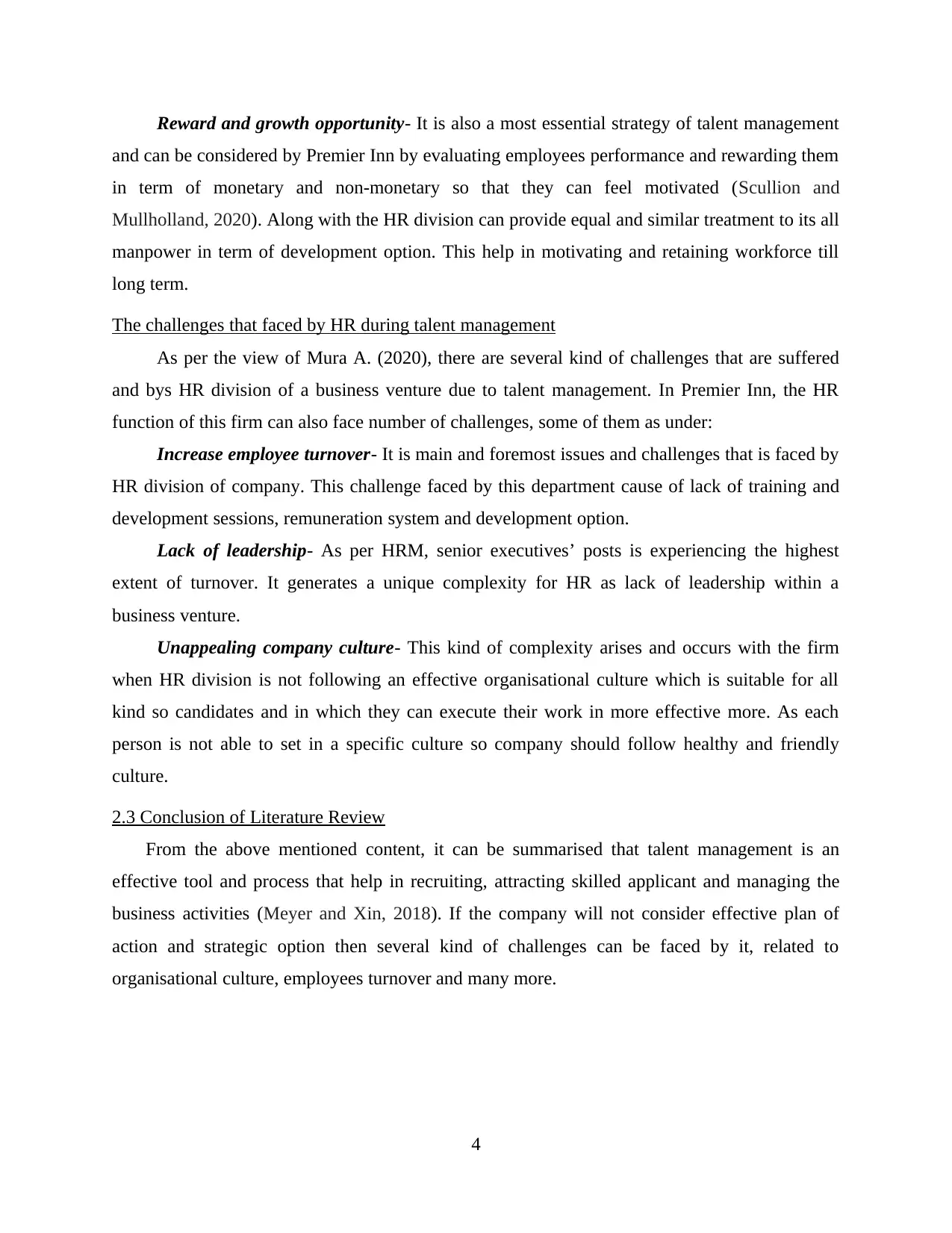
Reward and growth opportunity- It is also a most essential strategy of talent management
and can be considered by Premier Inn by evaluating employees performance and rewarding them
in term of monetary and non-monetary so that they can feel motivated (Scullion and
Mullholland, 2020). Along with the HR division can provide equal and similar treatment to its all
manpower in term of development option. This help in motivating and retaining workforce till
long term.
The challenges that faced by HR during talent management
As per the view of Mura A. (2020), there are several kind of challenges that are suffered
and bys HR division of a business venture due to talent management. In Premier Inn, the HR
function of this firm can also face number of challenges, some of them as under:
Increase employee turnover- It is main and foremost issues and challenges that is faced by
HR division of company. This challenge faced by this department cause of lack of training and
development sessions, remuneration system and development option.
Lack of leadership- As per HRM, senior executives’ posts is experiencing the highest
extent of turnover. It generates a unique complexity for HR as lack of leadership within a
business venture.
Unappealing company culture- This kind of complexity arises and occurs with the firm
when HR division is not following an effective organisational culture which is suitable for all
kind so candidates and in which they can execute their work in more effective more. As each
person is not able to set in a specific culture so company should follow healthy and friendly
culture.
2.3 Conclusion of Literature Review
From the above mentioned content, it can be summarised that talent management is an
effective tool and process that help in recruiting, attracting skilled applicant and managing the
business activities (Meyer and Xin, 2018). If the company will not consider effective plan of
action and strategic option then several kind of challenges can be faced by it, related to
organisational culture, employees turnover and many more.
4
and can be considered by Premier Inn by evaluating employees performance and rewarding them
in term of monetary and non-monetary so that they can feel motivated (Scullion and
Mullholland, 2020). Along with the HR division can provide equal and similar treatment to its all
manpower in term of development option. This help in motivating and retaining workforce till
long term.
The challenges that faced by HR during talent management
As per the view of Mura A. (2020), there are several kind of challenges that are suffered
and bys HR division of a business venture due to talent management. In Premier Inn, the HR
function of this firm can also face number of challenges, some of them as under:
Increase employee turnover- It is main and foremost issues and challenges that is faced by
HR division of company. This challenge faced by this department cause of lack of training and
development sessions, remuneration system and development option.
Lack of leadership- As per HRM, senior executives’ posts is experiencing the highest
extent of turnover. It generates a unique complexity for HR as lack of leadership within a
business venture.
Unappealing company culture- This kind of complexity arises and occurs with the firm
when HR division is not following an effective organisational culture which is suitable for all
kind so candidates and in which they can execute their work in more effective more. As each
person is not able to set in a specific culture so company should follow healthy and friendly
culture.
2.3 Conclusion of Literature Review
From the above mentioned content, it can be summarised that talent management is an
effective tool and process that help in recruiting, attracting skilled applicant and managing the
business activities (Meyer and Xin, 2018). If the company will not consider effective plan of
action and strategic option then several kind of challenges can be faced by it, related to
organisational culture, employees turnover and many more.
4
⊘ This is a preview!⊘
Do you want full access?
Subscribe today to unlock all pages.

Trusted by 1+ million students worldwide
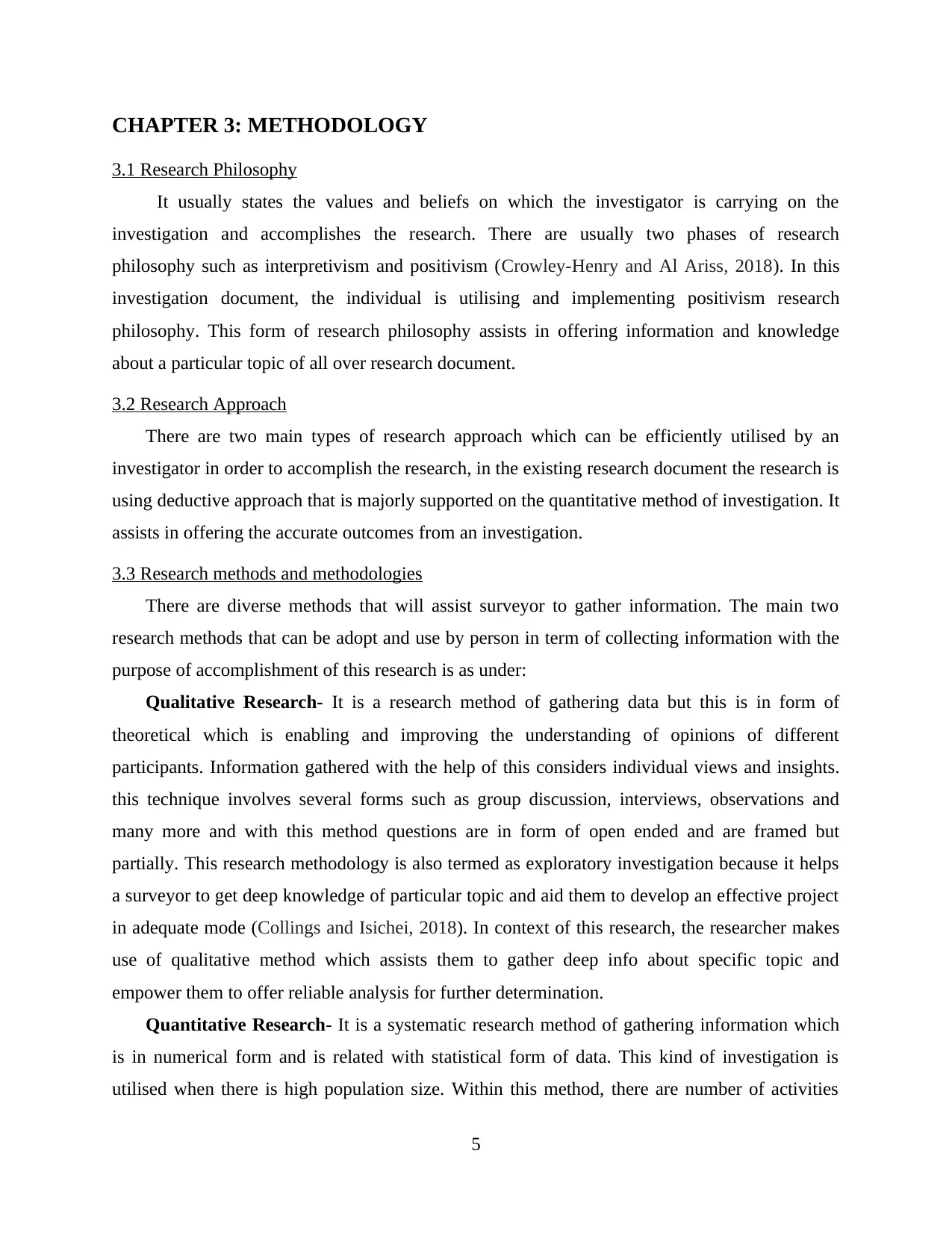
CHAPTER 3: METHODOLOGY
3.1 Research Philosophy
It usually states the values and beliefs on which the investigator is carrying on the
investigation and accomplishes the research. There are usually two phases of research
philosophy such as interpretivism and positivism (Crowley-Henry and Al Ariss, 2018). In this
investigation document, the individual is utilising and implementing positivism research
philosophy. This form of research philosophy assists in offering information and knowledge
about a particular topic of all over research document.
3.2 Research Approach
There are two main types of research approach which can be efficiently utilised by an
investigator in order to accomplish the research, in the existing research document the research is
using deductive approach that is majorly supported on the quantitative method of investigation. It
assists in offering the accurate outcomes from an investigation.
3.3 Research methods and methodologies
There are diverse methods that will assist surveyor to gather information. The main two
research methods that can be adopt and use by person in term of collecting information with the
purpose of accomplishment of this research is as under:
Qualitative Research- It is a research method of gathering data but this is in form of
theoretical which is enabling and improving the understanding of opinions of different
participants. Information gathered with the help of this considers individual views and insights.
this technique involves several forms such as group discussion, interviews, observations and
many more and with this method questions are in form of open ended and are framed but
partially. This research methodology is also termed as exploratory investigation because it helps
a surveyor to get deep knowledge of particular topic and aid them to develop an effective project
in adequate mode (Collings and Isichei, 2018). In context of this research, the researcher makes
use of qualitative method which assists them to gather deep info about specific topic and
empower them to offer reliable analysis for further determination.
Quantitative Research- It is a systematic research method of gathering information which
is in numerical form and is related with statistical form of data. This kind of investigation is
utilised when there is high population size. Within this method, there are number of activities
5
3.1 Research Philosophy
It usually states the values and beliefs on which the investigator is carrying on the
investigation and accomplishes the research. There are usually two phases of research
philosophy such as interpretivism and positivism (Crowley-Henry and Al Ariss, 2018). In this
investigation document, the individual is utilising and implementing positivism research
philosophy. This form of research philosophy assists in offering information and knowledge
about a particular topic of all over research document.
3.2 Research Approach
There are two main types of research approach which can be efficiently utilised by an
investigator in order to accomplish the research, in the existing research document the research is
using deductive approach that is majorly supported on the quantitative method of investigation. It
assists in offering the accurate outcomes from an investigation.
3.3 Research methods and methodologies
There are diverse methods that will assist surveyor to gather information. The main two
research methods that can be adopt and use by person in term of collecting information with the
purpose of accomplishment of this research is as under:
Qualitative Research- It is a research method of gathering data but this is in form of
theoretical which is enabling and improving the understanding of opinions of different
participants. Information gathered with the help of this considers individual views and insights.
this technique involves several forms such as group discussion, interviews, observations and
many more and with this method questions are in form of open ended and are framed but
partially. This research methodology is also termed as exploratory investigation because it helps
a surveyor to get deep knowledge of particular topic and aid them to develop an effective project
in adequate mode (Collings and Isichei, 2018). In context of this research, the researcher makes
use of qualitative method which assists them to gather deep info about specific topic and
empower them to offer reliable analysis for further determination.
Quantitative Research- It is a systematic research method of gathering information which
is in numerical form and is related with statistical form of data. This kind of investigation is
utilised when there is high population size. Within this method, there are number of activities
5
Paraphrase This Document
Need a fresh take? Get an instant paraphrase of this document with our AI Paraphraser
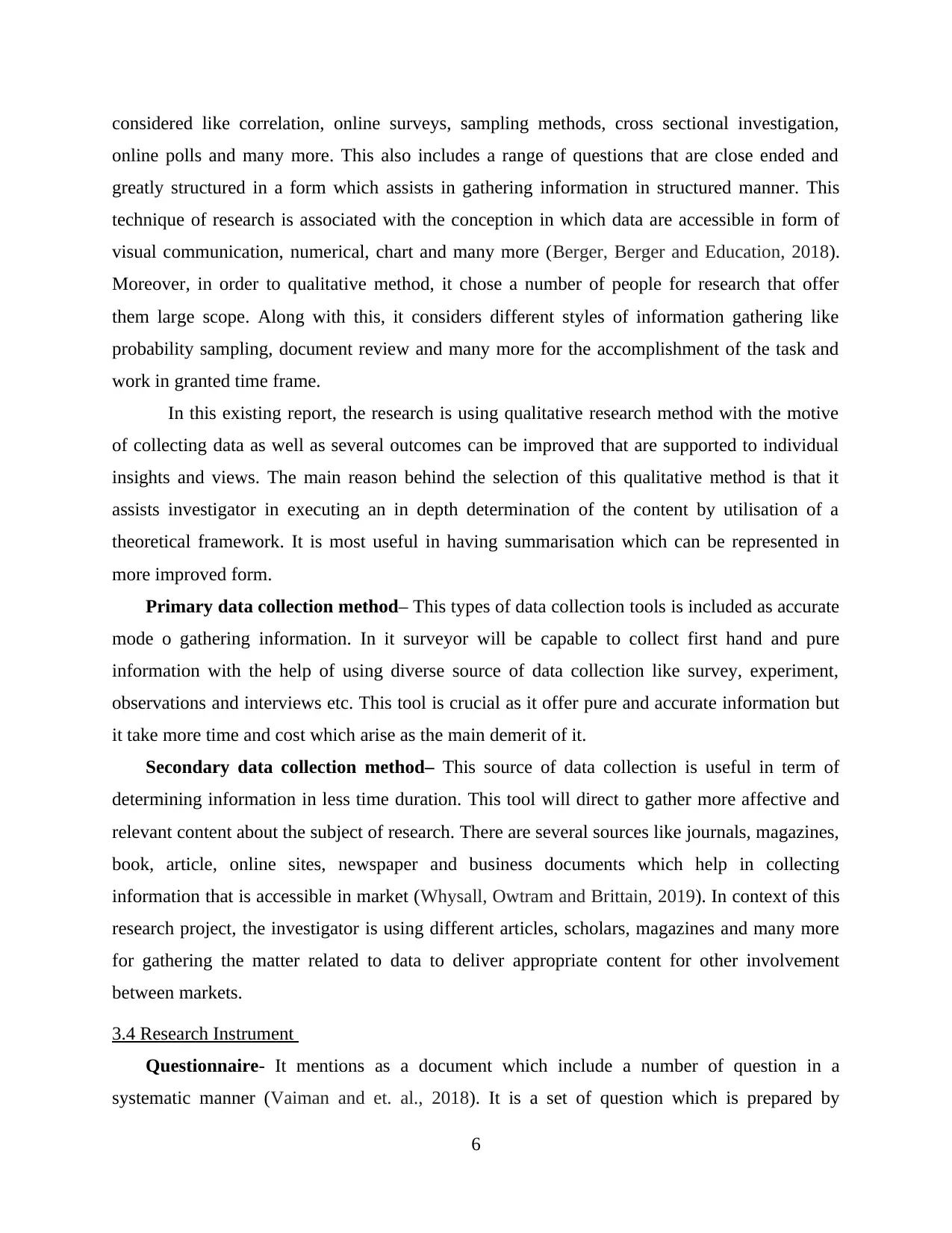
considered like correlation, online surveys, sampling methods, cross sectional investigation,
online polls and many more. This also includes a range of questions that are close ended and
greatly structured in a form which assists in gathering information in structured manner. This
technique of research is associated with the conception in which data are accessible in form of
visual communication, numerical, chart and many more (Berger, Berger and Education, 2018).
Moreover, in order to qualitative method, it chose a number of people for research that offer
them large scope. Along with this, it considers different styles of information gathering like
probability sampling, document review and many more for the accomplishment of the task and
work in granted time frame.
In this existing report, the research is using qualitative research method with the motive
of collecting data as well as several outcomes can be improved that are supported to individual
insights and views. The main reason behind the selection of this qualitative method is that it
assists investigator in executing an in depth determination of the content by utilisation of a
theoretical framework. It is most useful in having summarisation which can be represented in
more improved form.
Primary data collection method– This types of data collection tools is included as accurate
mode o gathering information. In it surveyor will be capable to collect first hand and pure
information with the help of using diverse source of data collection like survey, experiment,
observations and interviews etc. This tool is crucial as it offer pure and accurate information but
it take more time and cost which arise as the main demerit of it.
Secondary data collection method– This source of data collection is useful in term of
determining information in less time duration. This tool will direct to gather more affective and
relevant content about the subject of research. There are several sources like journals, magazines,
book, article, online sites, newspaper and business documents which help in collecting
information that is accessible in market (Whysall, Owtram and Brittain, 2019). In context of this
research project, the investigator is using different articles, scholars, magazines and many more
for gathering the matter related to data to deliver appropriate content for other involvement
between markets.
3.4 Research Instrument
Questionnaire- It mentions as a document which include a number of question in a
systematic manner (Vaiman and et. al., 2018). It is a set of question which is prepared by
6
online polls and many more. This also includes a range of questions that are close ended and
greatly structured in a form which assists in gathering information in structured manner. This
technique of research is associated with the conception in which data are accessible in form of
visual communication, numerical, chart and many more (Berger, Berger and Education, 2018).
Moreover, in order to qualitative method, it chose a number of people for research that offer
them large scope. Along with this, it considers different styles of information gathering like
probability sampling, document review and many more for the accomplishment of the task and
work in granted time frame.
In this existing report, the research is using qualitative research method with the motive
of collecting data as well as several outcomes can be improved that are supported to individual
insights and views. The main reason behind the selection of this qualitative method is that it
assists investigator in executing an in depth determination of the content by utilisation of a
theoretical framework. It is most useful in having summarisation which can be represented in
more improved form.
Primary data collection method– This types of data collection tools is included as accurate
mode o gathering information. In it surveyor will be capable to collect first hand and pure
information with the help of using diverse source of data collection like survey, experiment,
observations and interviews etc. This tool is crucial as it offer pure and accurate information but
it take more time and cost which arise as the main demerit of it.
Secondary data collection method– This source of data collection is useful in term of
determining information in less time duration. This tool will direct to gather more affective and
relevant content about the subject of research. There are several sources like journals, magazines,
book, article, online sites, newspaper and business documents which help in collecting
information that is accessible in market (Whysall, Owtram and Brittain, 2019). In context of this
research project, the investigator is using different articles, scholars, magazines and many more
for gathering the matter related to data to deliver appropriate content for other involvement
between markets.
3.4 Research Instrument
Questionnaire- It mentions as a document which include a number of question in a
systematic manner (Vaiman and et. al., 2018). It is a set of question which is prepared by
6
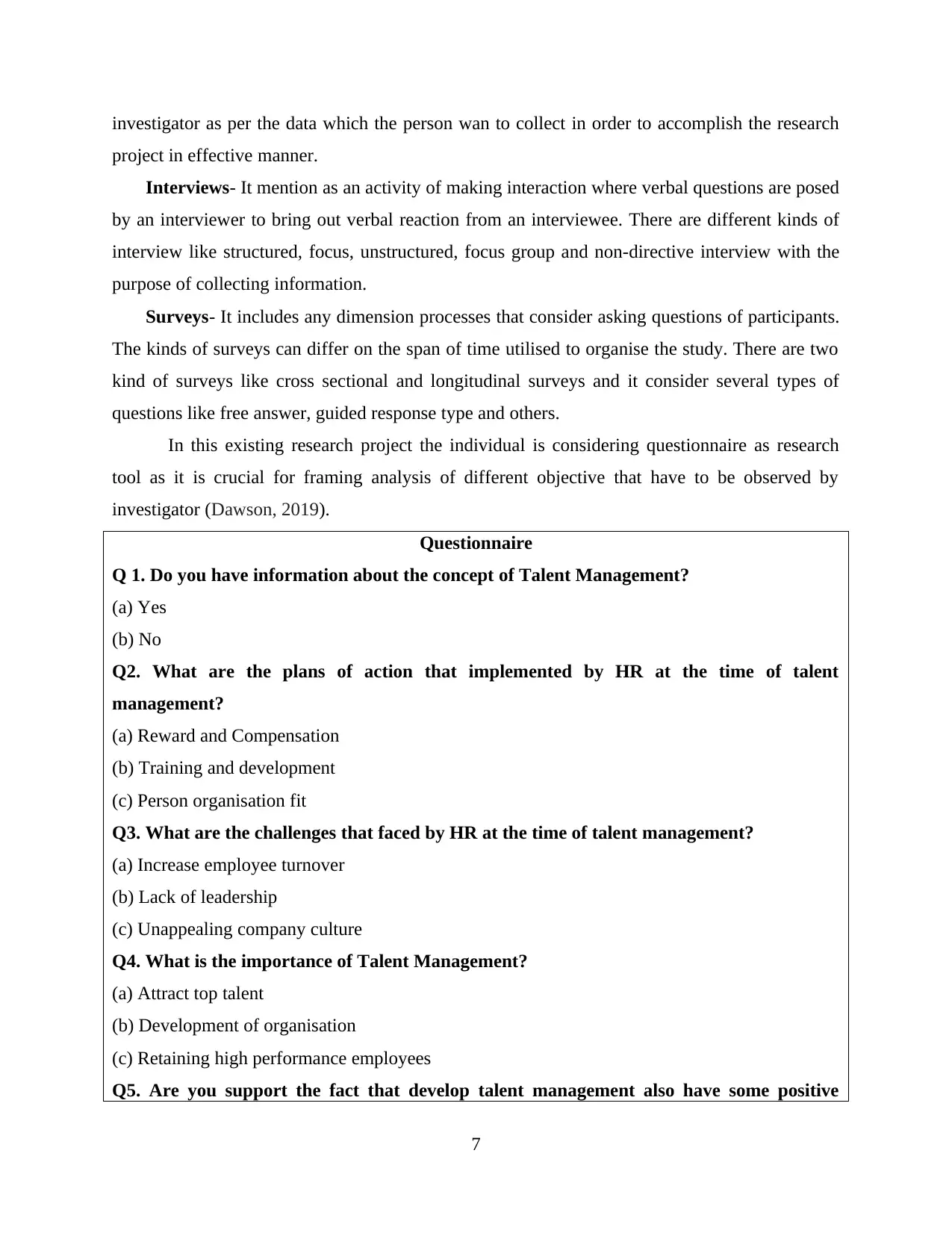
investigator as per the data which the person wan to collect in order to accomplish the research
project in effective manner.
Interviews- It mention as an activity of making interaction where verbal questions are posed
by an interviewer to bring out verbal reaction from an interviewee. There are different kinds of
interview like structured, focus, unstructured, focus group and non-directive interview with the
purpose of collecting information.
Surveys- It includes any dimension processes that consider asking questions of participants.
The kinds of surveys can differ on the span of time utilised to organise the study. There are two
kind of surveys like cross sectional and longitudinal surveys and it consider several types of
questions like free answer, guided response type and others.
In this existing research project the individual is considering questionnaire as research
tool as it is crucial for framing analysis of different objective that have to be observed by
investigator (Dawson, 2019).
Questionnaire
Q 1. Do you have information about the concept of Talent Management?
(a) Yes
(b) No
Q2. What are the plans of action that implemented by HR at the time of talent
management?
(a) Reward and Compensation
(b) Training and development
(c) Person organisation fit
Q3. What are the challenges that faced by HR at the time of talent management?
(a) Increase employee turnover
(b) Lack of leadership
(c) Unappealing company culture
Q4. What is the importance of Talent Management?
(a) Attract top talent
(b) Development of organisation
(c) Retaining high performance employees
Q5. Are you support the fact that develop talent management also have some positive
7
project in effective manner.
Interviews- It mention as an activity of making interaction where verbal questions are posed
by an interviewer to bring out verbal reaction from an interviewee. There are different kinds of
interview like structured, focus, unstructured, focus group and non-directive interview with the
purpose of collecting information.
Surveys- It includes any dimension processes that consider asking questions of participants.
The kinds of surveys can differ on the span of time utilised to organise the study. There are two
kind of surveys like cross sectional and longitudinal surveys and it consider several types of
questions like free answer, guided response type and others.
In this existing research project the individual is considering questionnaire as research
tool as it is crucial for framing analysis of different objective that have to be observed by
investigator (Dawson, 2019).
Questionnaire
Q 1. Do you have information about the concept of Talent Management?
(a) Yes
(b) No
Q2. What are the plans of action that implemented by HR at the time of talent
management?
(a) Reward and Compensation
(b) Training and development
(c) Person organisation fit
Q3. What are the challenges that faced by HR at the time of talent management?
(a) Increase employee turnover
(b) Lack of leadership
(c) Unappealing company culture
Q4. What is the importance of Talent Management?
(a) Attract top talent
(b) Development of organisation
(c) Retaining high performance employees
Q5. Are you support the fact that develop talent management also have some positive
7
⊘ This is a preview!⊘
Do you want full access?
Subscribe today to unlock all pages.

Trusted by 1+ million students worldwide
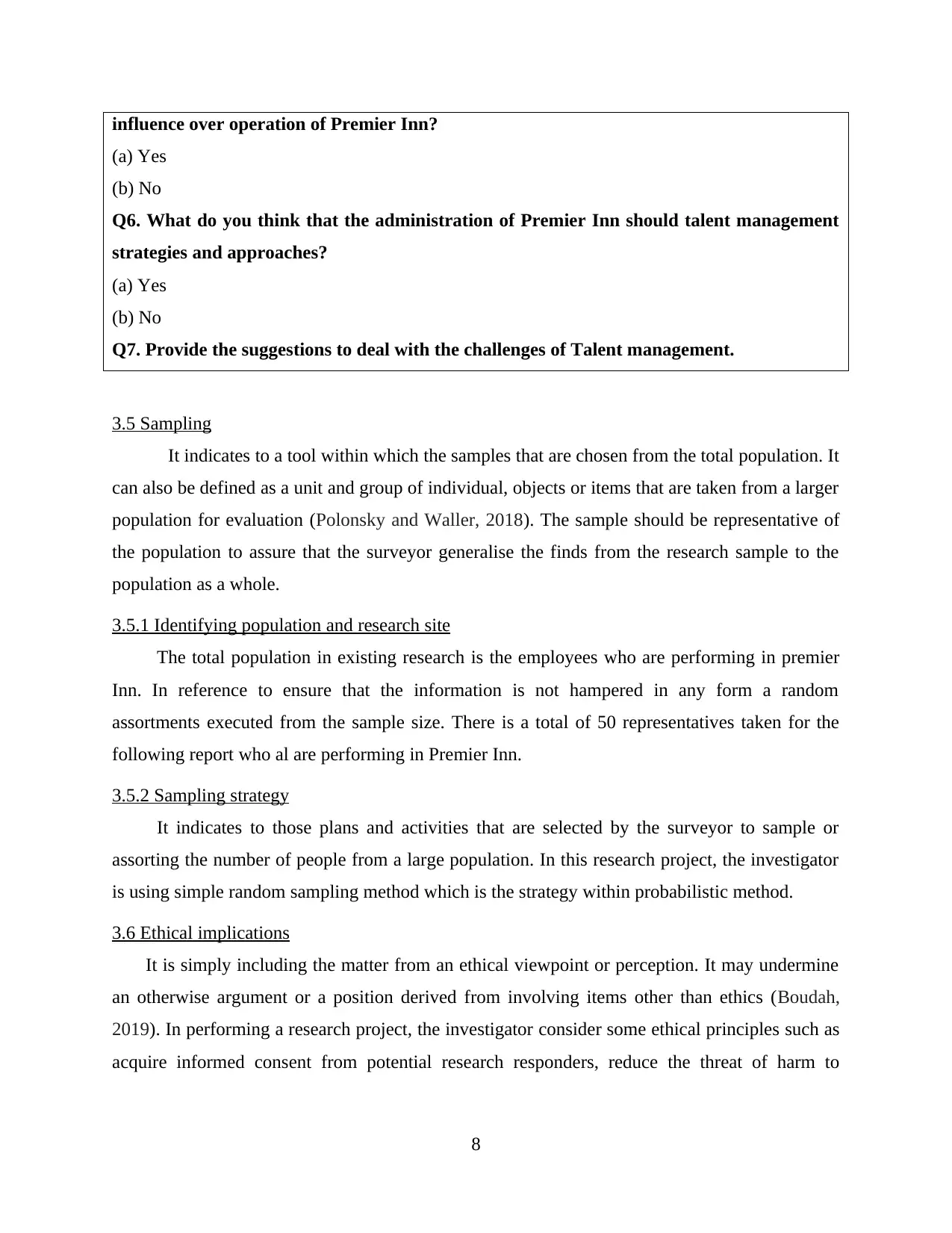
influence over operation of Premier Inn?
(a) Yes
(b) No
Q6. What do you think that the administration of Premier Inn should talent management
strategies and approaches?
(a) Yes
(b) No
Q7. Provide the suggestions to deal with the challenges of Talent management.
3.5 Sampling
It indicates to a tool within which the samples that are chosen from the total population. It
can also be defined as a unit and group of individual, objects or items that are taken from a larger
population for evaluation (Polonsky and Waller, 2018). The sample should be representative of
the population to assure that the surveyor generalise the finds from the research sample to the
population as a whole.
3.5.1 Identifying population and research site
The total population in existing research is the employees who are performing in premier
Inn. In reference to ensure that the information is not hampered in any form a random
assortments executed from the sample size. There is a total of 50 representatives taken for the
following report who al are performing in Premier Inn.
3.5.2 Sampling strategy
It indicates to those plans and activities that are selected by the surveyor to sample or
assorting the number of people from a large population. In this research project, the investigator
is using simple random sampling method which is the strategy within probabilistic method.
3.6 Ethical implications
It is simply including the matter from an ethical viewpoint or perception. It may undermine
an otherwise argument or a position derived from involving items other than ethics (Boudah,
2019). In performing a research project, the investigator consider some ethical principles such as
acquire informed consent from potential research responders, reduce the threat of harm to
8
(a) Yes
(b) No
Q6. What do you think that the administration of Premier Inn should talent management
strategies and approaches?
(a) Yes
(b) No
Q7. Provide the suggestions to deal with the challenges of Talent management.
3.5 Sampling
It indicates to a tool within which the samples that are chosen from the total population. It
can also be defined as a unit and group of individual, objects or items that are taken from a larger
population for evaluation (Polonsky and Waller, 2018). The sample should be representative of
the population to assure that the surveyor generalise the finds from the research sample to the
population as a whole.
3.5.1 Identifying population and research site
The total population in existing research is the employees who are performing in premier
Inn. In reference to ensure that the information is not hampered in any form a random
assortments executed from the sample size. There is a total of 50 representatives taken for the
following report who al are performing in Premier Inn.
3.5.2 Sampling strategy
It indicates to those plans and activities that are selected by the surveyor to sample or
assorting the number of people from a large population. In this research project, the investigator
is using simple random sampling method which is the strategy within probabilistic method.
3.6 Ethical implications
It is simply including the matter from an ethical viewpoint or perception. It may undermine
an otherwise argument or a position derived from involving items other than ethics (Boudah,
2019). In performing a research project, the investigator consider some ethical principles such as
acquire informed consent from potential research responders, reduce the threat of harm to
8
Paraphrase This Document
Need a fresh take? Get an instant paraphrase of this document with our AI Paraphraser
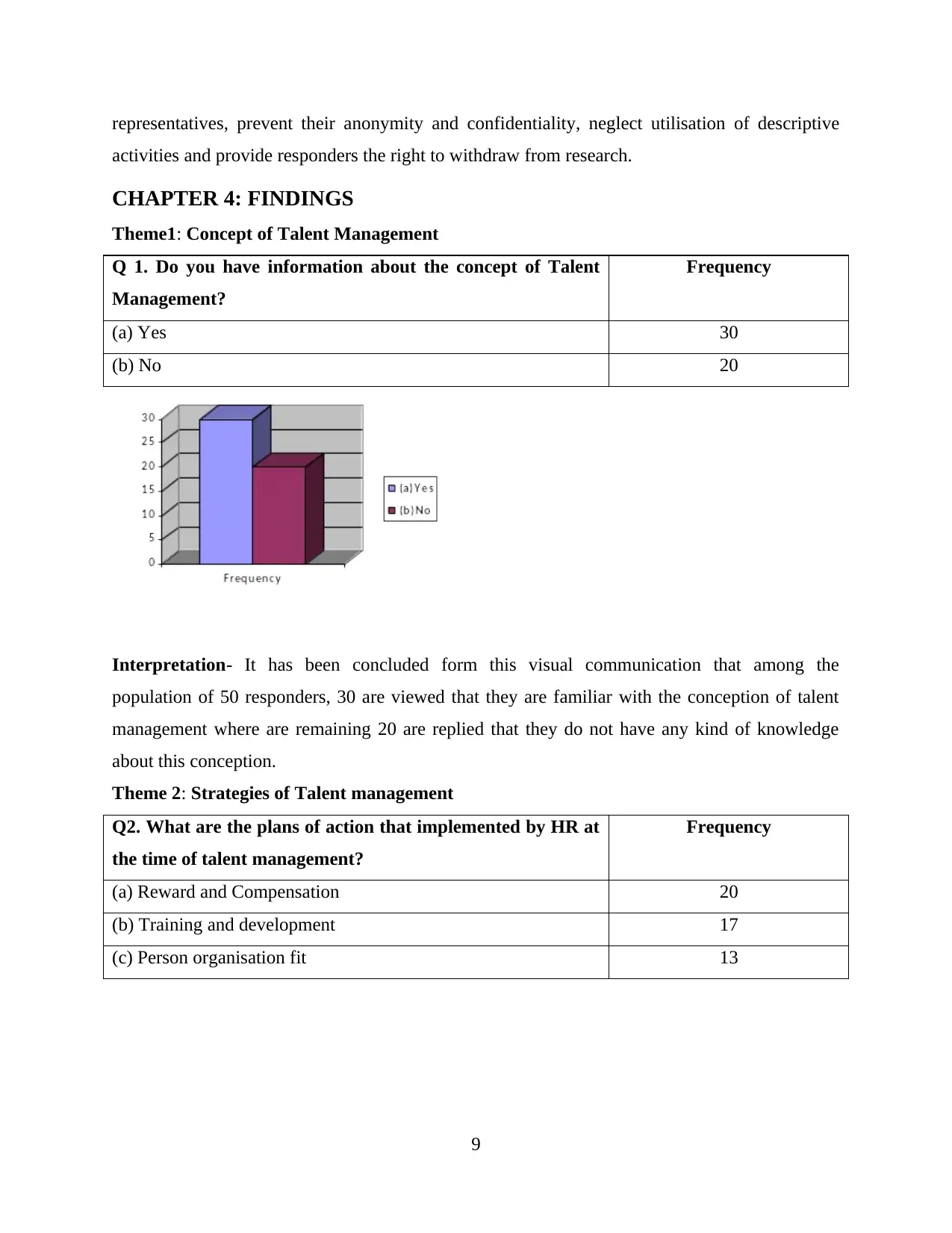
representatives, prevent their anonymity and confidentiality, neglect utilisation of descriptive
activities and provide responders the right to withdraw from research.
CHAPTER 4: FINDINGS
Theme1: Concept of Talent Management
Q 1. Do you have information about the concept of Talent
Management?
Frequency
(a) Yes 30
(b) No 20
Interpretation- It has been concluded form this visual communication that among the
population of 50 responders, 30 are viewed that they are familiar with the conception of talent
management where are remaining 20 are replied that they do not have any kind of knowledge
about this conception.
Theme 2: Strategies of Talent management
Q2. What are the plans of action that implemented by HR at
the time of talent management?
Frequency
(a) Reward and Compensation 20
(b) Training and development 17
(c) Person organisation fit 13
9
activities and provide responders the right to withdraw from research.
CHAPTER 4: FINDINGS
Theme1: Concept of Talent Management
Q 1. Do you have information about the concept of Talent
Management?
Frequency
(a) Yes 30
(b) No 20
Interpretation- It has been concluded form this visual communication that among the
population of 50 responders, 30 are viewed that they are familiar with the conception of talent
management where are remaining 20 are replied that they do not have any kind of knowledge
about this conception.
Theme 2: Strategies of Talent management
Q2. What are the plans of action that implemented by HR at
the time of talent management?
Frequency
(a) Reward and Compensation 20
(b) Training and development 17
(c) Person organisation fit 13
9
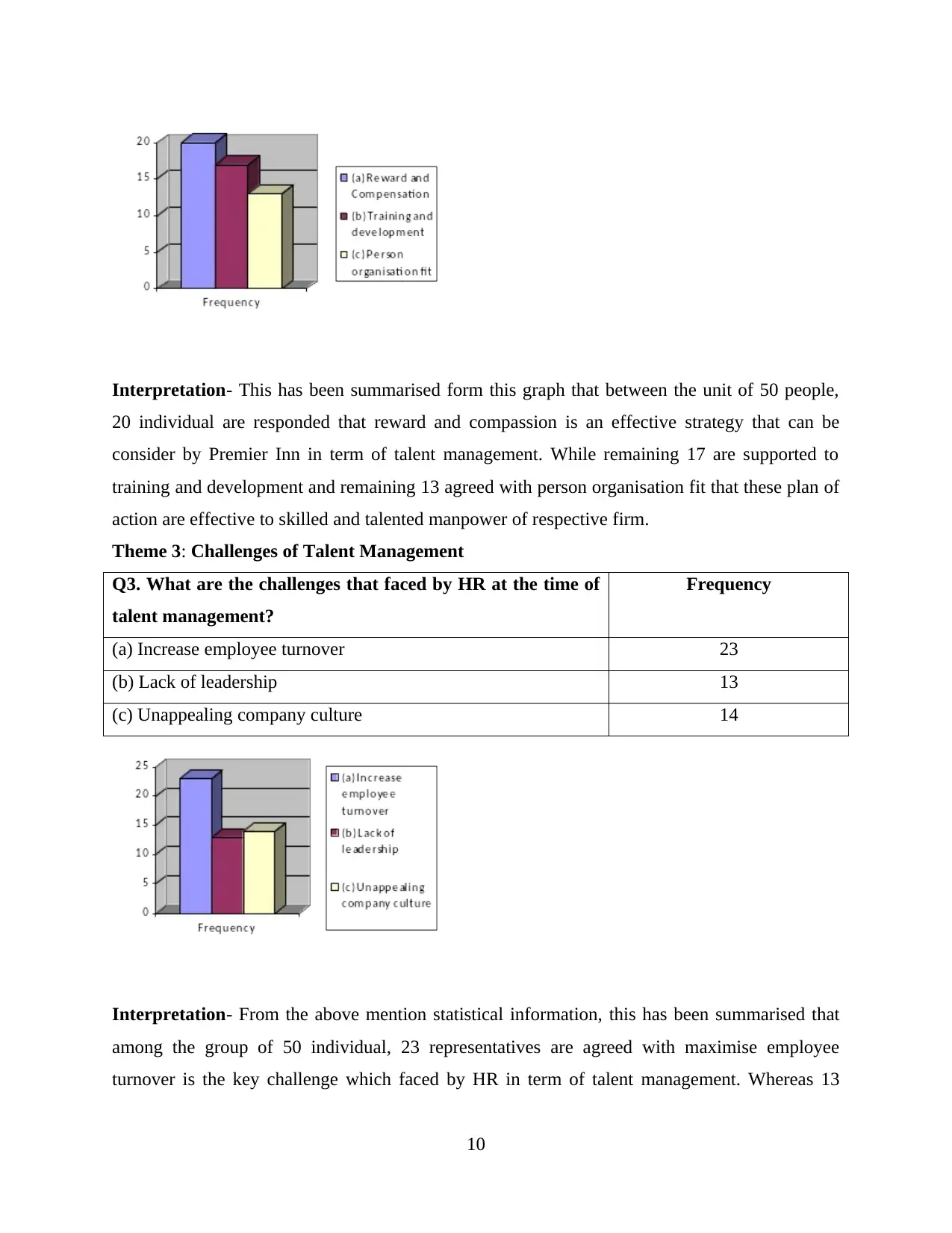
Interpretation- This has been summarised form this graph that between the unit of 50 people,
20 individual are responded that reward and compassion is an effective strategy that can be
consider by Premier Inn in term of talent management. While remaining 17 are supported to
training and development and remaining 13 agreed with person organisation fit that these plan of
action are effective to skilled and talented manpower of respective firm.
Theme 3: Challenges of Talent Management
Q3. What are the challenges that faced by HR at the time of
talent management?
Frequency
(a) Increase employee turnover 23
(b) Lack of leadership 13
(c) Unappealing company culture 14
Interpretation- From the above mention statistical information, this has been summarised that
among the group of 50 individual, 23 representatives are agreed with maximise employee
turnover is the key challenge which faced by HR in term of talent management. Whereas 13
10
20 individual are responded that reward and compassion is an effective strategy that can be
consider by Premier Inn in term of talent management. While remaining 17 are supported to
training and development and remaining 13 agreed with person organisation fit that these plan of
action are effective to skilled and talented manpower of respective firm.
Theme 3: Challenges of Talent Management
Q3. What are the challenges that faced by HR at the time of
talent management?
Frequency
(a) Increase employee turnover 23
(b) Lack of leadership 13
(c) Unappealing company culture 14
Interpretation- From the above mention statistical information, this has been summarised that
among the group of 50 individual, 23 representatives are agreed with maximise employee
turnover is the key challenge which faced by HR in term of talent management. Whereas 13
10
⊘ This is a preview!⊘
Do you want full access?
Subscribe today to unlock all pages.

Trusted by 1+ million students worldwide
1 out of 18
Related Documents
Your All-in-One AI-Powered Toolkit for Academic Success.
+13062052269
info@desklib.com
Available 24*7 on WhatsApp / Email
![[object Object]](/_next/static/media/star-bottom.7253800d.svg)
Unlock your academic potential
Copyright © 2020–2025 A2Z Services. All Rights Reserved. Developed and managed by ZUCOL.





